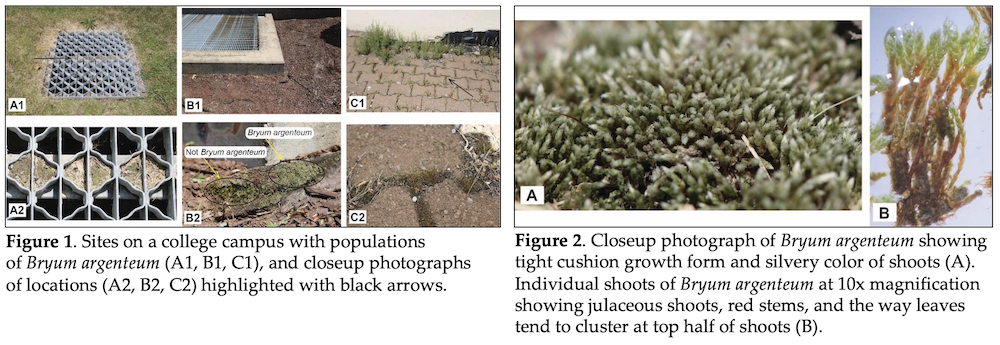Contact Project Leads: Erin Bissell (Metropolitan State University of Denver, ebissell@msudenver.edu); Denise Finney (Ursinus College, dfinney@ursinus.edu); Sean Robinson (SUNY Oneonta, sean.robinson@oneonta.edu)
Initiated: 2022
Project Status: Pilot-testing methods in Fall 2022. Recruiting new participants for Spring 2023.
Description
Of Moss and Men: Moss Phenology in Built Environments
Mosses are integral to the development and function of ecosystems ranging from boreal forests to hot, dry deserts. Mosses affect soil formation and retention, influence nutrient cycling, mediate humidity and moisture, and serve as a habitat for diverse assemblages of organisms. While mosses are adapted to a wide range of habitats, there are significant gaps in our understanding of how these small but mighty members of the plant kingdom reproduce and disperse. This project will use open access data from iNaturalist and local field observations to determine how moss phenology and reproductive traits are influenced by biotic and abiotic factors from local to continental scales. We will also explore how human land use generates cross-scale interactions that shape moss phenology.

Hypotheses/Objectives:
Moisture is frequently identified as a key driver of moss reproductive phenology, therefore, it is expected that effects of human land use on the emergence of spore-producing bodies (sporophytes) will vary by season and/or microhabitat.
We predict that sporophytes in mosses growing in natural environments (i.e. those growing on substrates such as rock or undisturbed soils and/or in ecosystems such as forests and grasslands) will emerge earlier than those in mosses growing in built environments (i.e. growing on substrates such as cement, asphalt, or managed soils and/or in developed land uses) in spring and later in the fall.
Mosses in built environments are also expected to demonstrate differences in characteristics that impact spore dispersal from mosses growing in natural environments.
We predict that sporophyte density will be higher and sporophytes taller in natural versus built environments due to greater water retention in natural areas and selection pressures favoring shorter stature in built environments.
Summary of Methods:
To test these hypotheses, participants will collect data on the emergence time, density, and height of sporophytes of the cosmopolitan moss, Bryum argenteum. The extensive geographic range and tolerance to urban environments of this species will allow for compilation of a dataset that can be used to assess variation in these characteristics from local to continental scales. The project employs two approaches to data collection, and participants may choose to use one or both of these approaches to evaluate hypotheses within and across sites. Spatial analysis will be used to identify phenological patterns at the continental scale and in response to land use.
Approach 1: Local field observations
Students will identify populations of Bryum argenteum on their campus and surrounding natural areas growing on built and natural substrates. If Bryum argenteum is not observed, faculty can elect to have their students identify and sample another moss species prevalent in their area. They will then collect data on sporophyte presence/absence, maturity, density, and height and additional relevant environmental variables (e.g., surrounding vegetation, microtopography, aspect, shade).
Approach 2: Characterization of existing iNaturalist observations
Students will use iNaturalist observations to determine the timing of sporophyte appearance and maturation in Bryum argenteum and potentially other mosses occuring on built and natural substrates.
Expanded Project Info.
Curriculum: Instructor materials are on the way. Stay tuned.
Other Project Materials: Stay tuned.
Publications from this project will be listed here as available.
